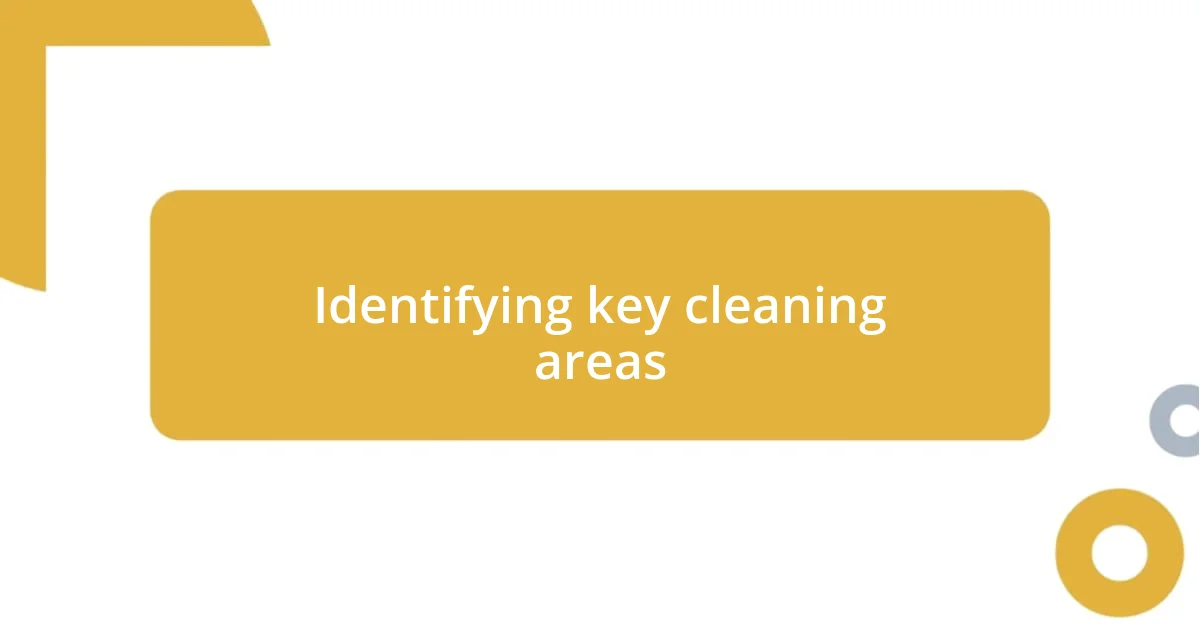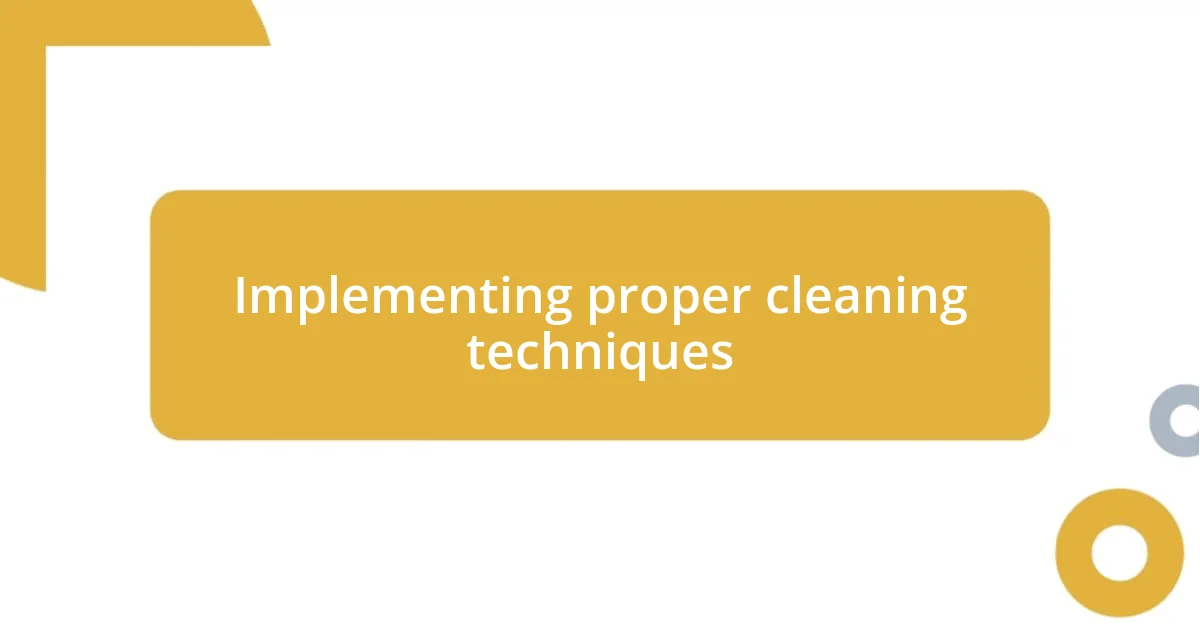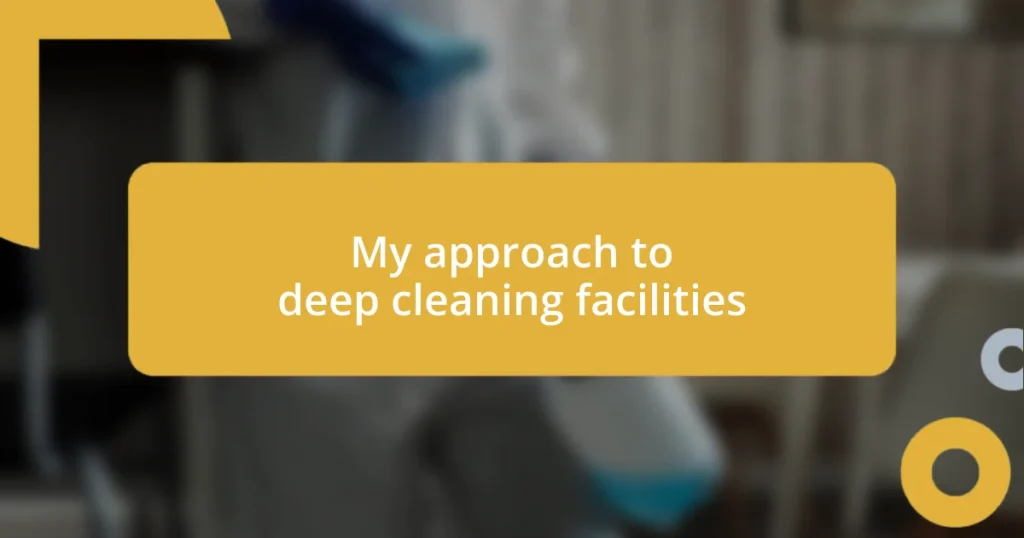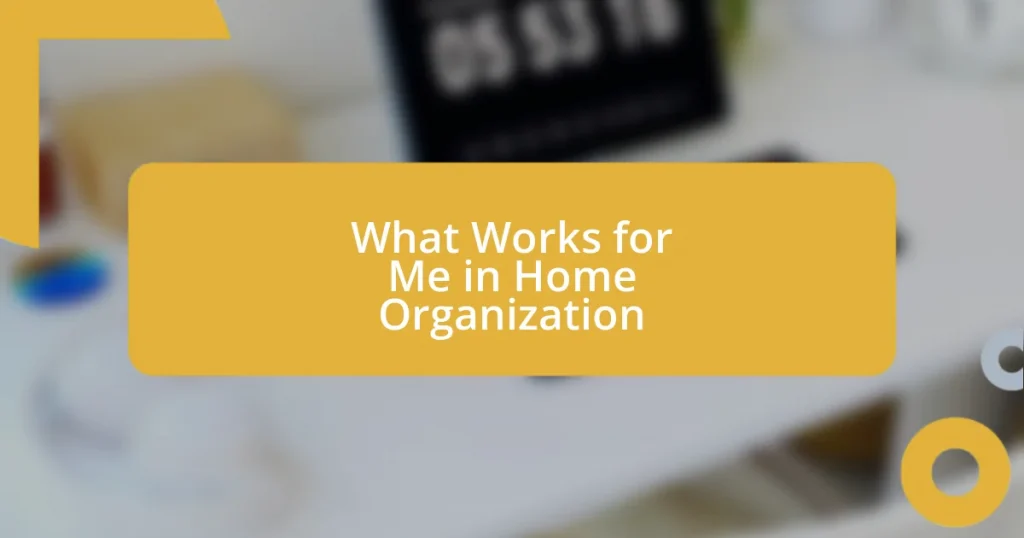Key takeaways:
- Deep cleaning transcends regular cleaning by focusing on overlooked areas, enhancing both hygiene and emotional well-being.
- Implementing a systematic approach, including identifying key cleaning areas and using appropriate supplies, is crucial for effective results.
- Evaluating cleaning outcomes through checklists and feedback fosters continuous improvement and accountability in maintaining clean environments.

Understanding deep cleaning processes
Deep cleaning goes beyond the regular cleaning routine; it’s about addressing those overlooked areas that accumulate dirt and grime over time. I remember the first time I tackled a deep clean in a facility—I was shocked at how much dust had settled behind appliances and furniture. Have you ever felt that rush of accomplishment when you discover a space you thought was clean but was actually hiding years of buildup?
When I think about deep cleaning processes, I also realize the emotional aspect of the task. The act of deep cleaning can feel cathartic, almost like shedding a burden. It’s fascinating how a clean environment can elevate your mood; just imagine stepping into a space that feels fresh and revitalized after a thorough clean. Isn’t it incredible how cleanliness impacts not just our surroundings, but our mental state too?
One of the key components of deep cleaning is having a systematic approach—prioritizing tasks and using the right tools can make all the difference. In my experience, I’ve found that breaking down tasks into manageable chunks not only makes the job less daunting but also allows me to appreciate the transformation as I go. Have you ever noticed how a well-organized plan can turn a seemingly overwhelming task into something achievable?

Identifying key cleaning areas
Identifying key areas that require deep cleaning is crucial for an effective clean. When I first started, I remember walking through a facility with a discerning eye. I quickly learned to focus on places that people often overlook, like behind large furniture or inside cabinets.
Here are some key cleaning areas to prioritize:
– High-Traffic Zones: Entryways, hallways, and communal areas that collect dirt quickly.
– Restrooms: These need extra attention due to moisture and bacteria.
– Kitchens: Pay special attention to appliances and under sinks, as crumbs and spills can build up.
– HVAC Systems: These often neglected areas can harbor dust and allergens.
– Surfaces and Fixtures: Regularly touched surfaces like light switches and door handles can accumulate germs.
I vividly recall a time when I discovered an astounding amount of dust lurking behind a vending machine. I felt a mix of disgust and determination. It reminded me that sometimes, the most impactful results come from unveiling the unseen, transforming spaces we had long taken for granted. It’s in these moments that I find motivation to create cleaner, healthier environments.

Selecting effective cleaning supplies
Selecting effective cleaning supplies is a critical step in achieving a successful deep clean. I’ve learned that not all products are created equal; some are designed for specific tasks while others serve multiple purposes. For example, I once used a general-purpose cleaner for everything, thinking it would save me time. However, it wasn’t until I tried a specialized disinfectant on bathroom surfaces that I truly appreciated the value of targeted cleaning supplies. Don’t you think having the right tool for the job can make a world of difference?
When choosing cleaning supplies, it’s essential to consider safety and environmental impact. I vividly remember a time when I tackled a project using strong chemical cleaners, and I ended up with headaches and irritation from the fumes. Since then, I always look for eco-friendly options that are safe for both the environment and our health. Brands that prioritize biodegradable ingredients tend to be more effective, leaving spaces clean without harming our planet. Have you experienced the uplifting feeling of cleaning without those harsh chemicals?
Lastly, important factors to evaluate include the efficacy of the products and their compatibility with surfaces. My experience has shown that using products that work effectively while being safe for various materials is a game-changer. For instance, I once ruined a countertop with a harsh abrasive cleaner, and that taught me the importance of product-label reading. Do you take the extra time to research supplies before jumping into a cleaning project?
| Type of Cleaning Supply | Best Uses |
|---|---|
| All-Purpose Cleaner | Surfaces like countertops, desks, and tables. |
| Disinfectant Spray | Restrooms and kitchen areas, particularly on high-touch surfaces. |
| Eco-Friendly Cleaner | General cleaning without harsh chemicals, safe for family and pets. |
| Abrasive Cleaner | Kitchen appliances and tough grime on floors, use sparingly. |

Creating a deep cleaning schedule
Creating a deep cleaning schedule can significantly streamline the cleaning process. I’ve found that breaking down tasks into manageable chunks makes the overwhelming seem achievable. It’s like assembling a puzzle; you work on one piece at a time. Consider using a calendar or a planner to designate specific cleaning days for each area, ensuring nothing is neglected. Does it really help to map it all out? Absolutely! When I’ve planned cleaning sessions in advance, I not only stay organized, but I also create a rhythm that feels satisfying.
I remember the first time I implemented a weekly rotation in a facility I managed. Personally, I tackled high-traffic zones on Mondays when everyone was back at work, allowing for maximum impact. By incorporating a color-coded system, I could easily see what had been done and what was still pending. It felt gratifying to visually witness the progress. Have you ever experienced that sense of accomplishment that comes with checking off tasks? Scheduling provides that sense of order and control that I crave.
Months later, I adjusted my schedule based on feedback from staff. Some areas, like restrooms, required more frequent attention, whereas others could be tackled biweekly. I learned that flexibility is vital; what works today might need adjustment tomorrow. Keeping communication lines open among team members ensures everyone feels heard and included in the process. Isn’t it refreshing to think that we can adapt and improve our cleaning schedules based on real-world experience?

Implementing proper cleaning techniques
When it comes to deep cleaning, implementing proper techniques is where the real magic happens. I remember my first attempt at tackling a particularly grimy break room. I was armed with all the right supplies, but I realized I was skipping crucial steps, like pre-soaking stubborn stains. By taking the time to break down the process into stages—dusting, scrubbing, and rinsing—I spotted the difference in my results. It’s amazing how attention to detail can elevate the quality of your work.
One technique I’ve come to rely on is the “top-to-bottom” method, which may sound simple, but it’s truly effective. On a recent cleaning day, I decided to fully commit to this approach in our office space and started from the highest shelves, letting dust fall so I could easily clean it up later. It not only saved me time but also ensured that I didn’t just move dirt around. Have you ever tried cleaning a room in reverse order? It’s a game changer. Seeing the dust-free surfaces gradually emerge felt incredibly satisfying; I couldn’t help but smile at my progress.
Lastly, don’t underestimate the power of focused cleaning sessions. Recently, I dedicated an hour to deep cleaning the restroom, which often gets overlooked due to its size. I set a timer, blasting some music to keep my motivation up. The sense of accomplishment was palpable as I transformed a neglected space into a sparkling gem of hygiene. Have you ever found that a time limit can actually boost your productivity? The result was not just a clean restroom, but also a sense of pride in creating a pleasant environment for everyone.

Ensuring safety and compliance measures
Ensuring safety during deep cleaning is of utmost importance. I always make it a point to review safety data sheets (SDS) for any cleaning products I use. This practice isn’t just a formality; it gives me peace of mind knowing that I’m aware of potential hazards. Have you ever checked the labels on your cleaning supplies? It’s eye-opening to see the chemical ingredients and their effects.
Another critical aspect is adhering to compliance measures that protect both staff and the environment. During one massive cleaning operation, we adopted green cleaning products that meet eco-friendly standards. I felt good knowing that we weren’t just prioritizing cleanliness but also safeguarding the health of our team and the building’s occupants. Don’t you think that makes a difference?
Lastly, using proper personal protective equipment (PPE) is essential in my approach. I still remember a day when a colleague forgot to wear gloves while handling disinfectants. The look of concern on their face was a stark reminder of why I always emphasize this step. I routinely hold brief training sessions to reinforce the significance of PPE. I’ve found that when people understand the ‘why,’ they are more likely to follow through. Isn’t it reassuring to know that such simple measures can drastically enhance safety?

Evaluating the cleaning outcomes
Evaluating the outcomes of deep cleaning goes beyond just looking at shiny surfaces. I remember recently assessing a kitchen after a thorough clean; on the surface, everything looked immaculate, but I noticed a lingering smell. It turned out that a bit of leftover grime had hidden itself in the hard-to-reach corners. Have you ever thought about how a clean space can still have hidden issues? It reminds me that a comprehensive evaluation is essential for truly understanding the effectiveness of our efforts.
One tactic I’ve embraced is using a checklist to visually assess each area post-cleaning. After I implemented it during a spring cleaning day, I found it not only kept me accountable but also helped me pinpoint areas that required more attention. There was a surprising thrill when I ticked off each section, but it was even more rewarding to realize where I could improve next time. Don’t you love that feeling of progress? It’s incredible how small tools, like a checklist, can enhance the overall evaluation process.
Finally, I always seek feedback from my colleagues after a big clean. Just last month, I asked for their thoughts on the office’s appearance. Their responses were invaluable; while some appreciated the clean floors, others pointed out that the break room could still use a little TLC. Reflecting on feedback creates a culture of continuous improvement. Have you ever considered how group input can shape your cleaning strategies? This collaborative approach not only strengthens our outcomes but also fosters ownership of our shared spaces.















